Photography is key in keeping culture, memories, and stories alive in the Philippines. It’s a big part of Filipino traditions and celebrations. It lets people capture and share moments that show their culture and values.
With services like those from Great Image, Filipinos can keep family memories alive. They can capture traditions and celebrate big moments with top-notch photos. These photos show love, joy, and family bonds.
The photography world is always changing. It’s important to see how photography helps keep Filipino culture alive. Great Image, with 40 years of experience, leads in professional photography. They offer special perks and deals, like the Great Image Gratitude Card and the Collection of Love promo.
Key Takeaways
- Photography is vital in keeping culture, memories, and stories alive in the Philippines.
- Services like Great Image help keep family memories and traditions alive.
- Family portraits are important records of family history and memories for the future.
- Photography shows Filipino values like family, respect for elders, and love for heritage.
- The photography industry in the Philippines is growing, focusing on quality images that show love and family.
The Rich History of Photography in the Philippines
Photography in the Philippines started in the 1840s. The first photo studios opened in the 1850s. Photography has been key in sharing Filipino stories ever. With social media, it’s even more important, letting people share their lives with many.
Many photographers, both foreign and local, have shaped photography here. Westerners like Albert Honnis and Francisco van Kamp worked here early on. Félix Laureano, the first Filipino photographer, and Philinda Rand, an American, also made significant contributions. They mixed visual stories with cultural documentation.
- The Menage Expedition photographs, taken by American men in the early 1890s, which provide a glimpse into the lives of rural Filipinos during that time.
- The work of Dean Conant Worcester, an American photographer who produced nude photographs of Philippine tribal women and documented the transformation of the Filipino people during the early 20th century.
- The golden era of postcards, which saw the production of over 677 million postcards during the first fiscal year, and the subsequent decline in popularity of postcards during the White Border Era.
These moments have enriched photography in the Philippines. Today, with social media and digital tools, photography is more accessible. It lets Filipinos share their visual stories with everyone.
The Role of Photography in Filipino Culture
Photography is very important in Filipino culture. It helps keep memories alive and shows off the country’s rich culture. Filipinos use it to record their festivals, family times, and big moments. This way, they create a visual story of their heritage.
Photography is a big part of Filipino life. It lets people show their creativity and share their stories. Whether it’s the bright colors of a festival or a family’s special moments, photos can move us and make memories last.
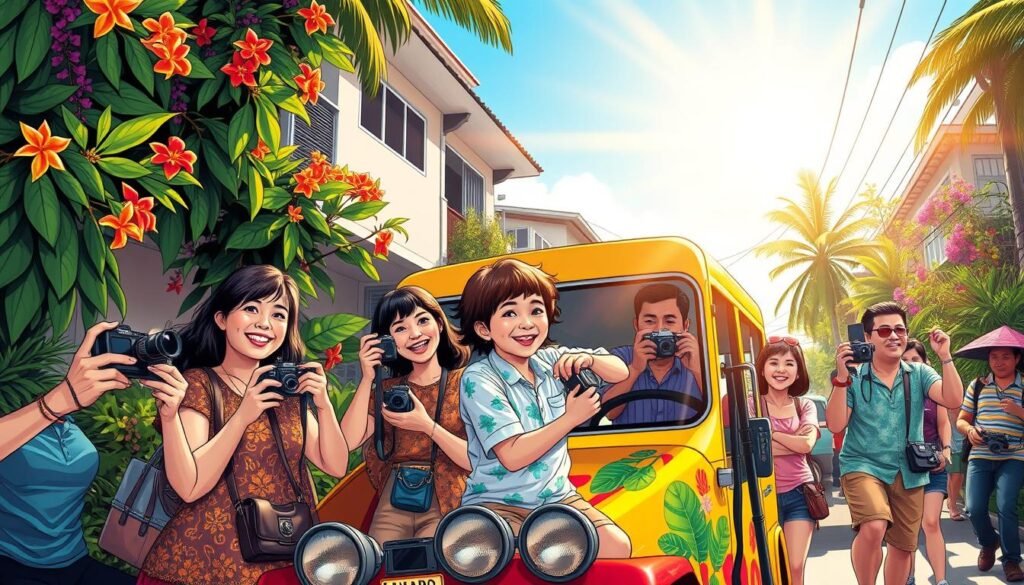
Photography is a way for Filipinos to express their culture to the world. By taking pictures of their everyday lives, traditions, and customs, they show the world the beauty and variety of their culture. This helps people understand and appreciate different cultures more.
Popular Photography Styles in the Philippines
Photography in the Philippines is vibrant and diverse. The country’s culture and landscapes inspire many photographers. With social media, photography is now more accessible, reaching a global audience.
Photography is a way to express creativity and tell stories. Filipino photographers have gained fame locally and internationally. Geloy Concepcion, for example, has worked with VICE, Esquire, and CNN Philippines. He also has a big following on Instagram.
Portrait Photography
Portrait photography is very popular in the Philippines. Photographers focus on capturing their subjects’ beauty and essence. It requires understanding lighting, composition, and connecting with the subject.
Landscape and Nature Photography
Landscape and nature photography are also favorites. The Philippines’ landscapes and wildlife offer endless photo opportunities. From mountains to beaches, it’s a paradise for nature and photography enthusiasts.
Street Photography
Street photography is gaining popularity too. Photographers capture the daily lives and struggles of people. It demands a keen eye for detail and the ability to tell stories through images.
These styles showcase the Philippines’ beauty and let photographers express their creativity. With social media growing, it’s exciting to see photography in the Philippines evolve further.
| Photography Style | Description |
|---|---|
| Portrait Photography | Capturing the beauty and essence of a subject |
| Landscape and Nature Photography | Capturing the beauty of landscapes and wildlife |
| Street Photography | Capturing the daily lives and struggles of people |
The Rise of Mobile Photography
Mobile photography has become a big part of Filipino culture. It lets people easily capture and share stories. With smartphones, documenting daily life, special moments, and traditions is simple.
Social media has greatly influenced photography. Sites like Instagram and Facebook host billions of photos. By 2012, Instagram had over 4 billion photos, and Facebook had over 250 billion by 2013. Most of these were taken with smartphones.
This has opened up new ways for mobile photographers to share their work. They can connect with others who value their art.
Some trends in mobile photography among Filipinos include:
- Using smartphones to capture high-quality photos and videos
- Sharing photos on social media platforms to connect with others and showcase their work
- Participating in mobile photography contests and exhibitions to gain recognition and feedback
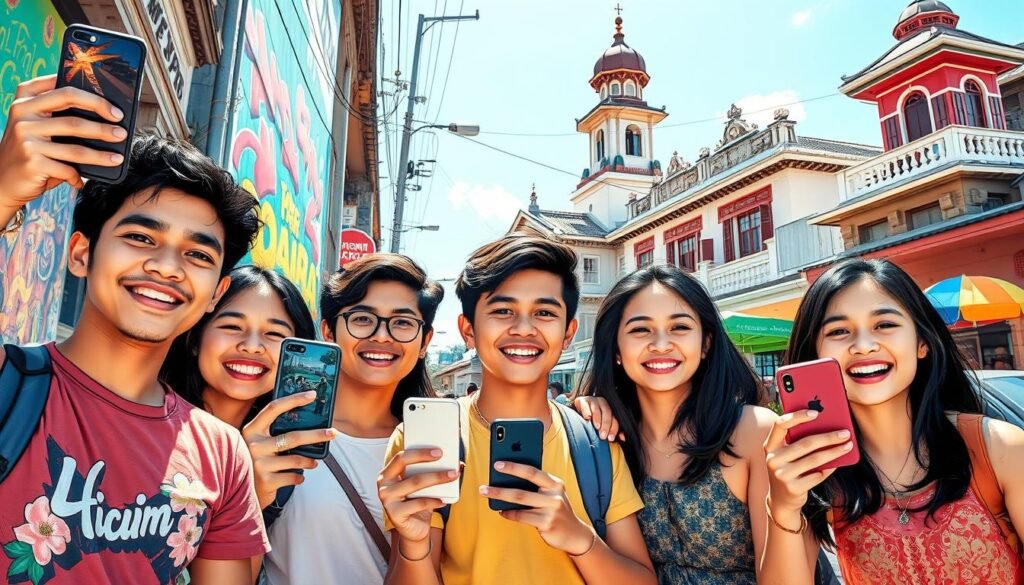
The rise of mobile photography has made photography more accessible. It lets people from all backgrounds capture and share their stories and experiences. As technology advances, it will be interesting to see how Filipino culture and photography keep influencing each other.
| Platform | Number of Photos |
|---|---|
| 4 billion | |
| 250 billion |
Photography Education and Communities
Photography education and communities are key in the Philippines. Schools like the School of Photography offer courses for beginners to advanced. They teach everything from basic photography to advanced techniques like studio lighting.
Online platforms and resources help photographers learn and grow. Social media lets them share their work and connect with others. The School of Photography is a great example, with thousands of videos and worksheets.
Local photography clubs offer support and a sense of community. They host workshops, exhibitions, and competitions. This helps photographers improve and showcase their work. Joining these groups is easy with social media.
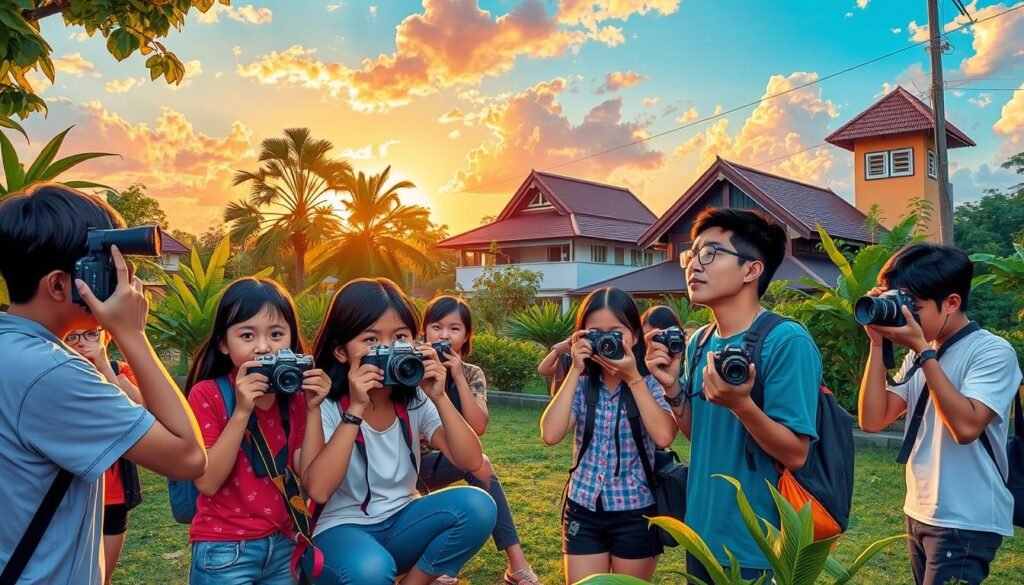
Photography education and communities are vital for growth in the Philippines. They offer learning, sharing, and connecting opportunities. This helps promote photography and builds a community of photographers.
The Influence of Social Media on Photography
Social media has changed how photographers share their work and connect with people. In the Philippines, it’s key for photographers to share their memories and experiences online. With millions on Instagram and Facebook, they can show their skills to more people.
Instagram sees 95 million photos and videos shared daily. This makes it tough for photographers to stand out. But, it also helps them meet others who like their work, making networking easier.

Social media lets photographers show their work and gain followers. They can skip traditional magazines and galleries. This has opened up the photography world, giving more people a chance to succeed.
Some good things about social media for photography are:
- More people see your work
- It’s easier to meet and work with others
- You can build a portfolio and followers
- You reach more people and find clients
By using social media, photographers can build a strong online presence. They can share their stories and show their talent to the world. This enriches the photography culture in the Philippines.
Ethical Considerations in Photography
Photographers must think about how their work affects others. This includes respecting privacy in public and being sensitive to different cultures. The industry is moving towards a new way of thinking about ethics, focusing on principles over rules.
Photographers need to understand ethics deeply. This means being able to think critically, be aware of situations, and respect different cultures. This approach helps photographers make better choices.
On social media, photographers face challenges like privacy issues and exploitation. It’s key to get consent from subjects and keep talking to them. Also, knowing about copyright laws is important. It helps protect a photographer’s work.
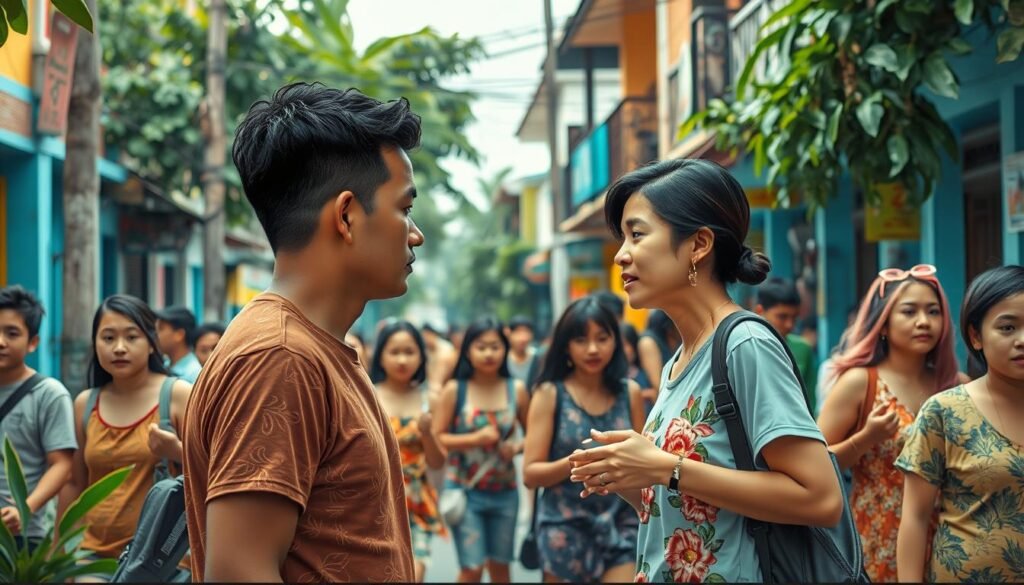
- Respecting privacy in public spaces and obtaining informed consent before taking someone’s picture
- Being culturally sensitive and aware of local customs and norms
- Protecting intellectual property rights through copyright laws and watermarking
- Avoiding exploitation and misrepresentation of vulnerable subjects
By focusing on ethics, photography can become more respectful and honest. This improves the world of visual and social media.
Technological Advancements in Photography
Photography has changed a lot over the years, thanks to new technology. Digital cameras came out in 1995, switching from film to digital. This change let people share their stories and photos easily.
Now, we can take color photos and share them online. Camera phones and photo scanning services make it simple. Studies show cloud storage is popular for keeping photos safe and easy to find.
Some benefits of digital photography are:
- Improved image quality
- Easier sharing and storage
- Increased accessibility
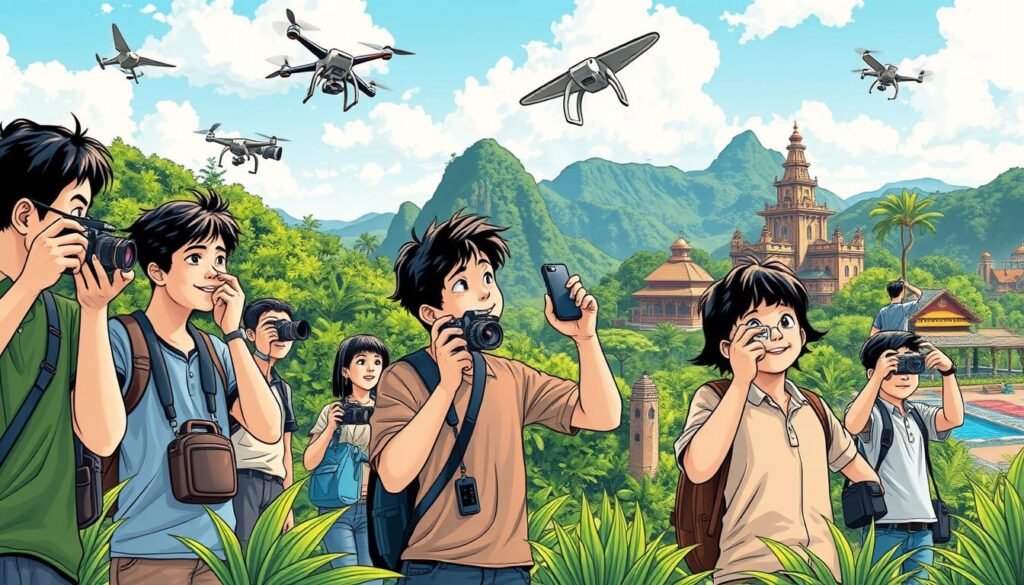
Technology keeps getting better, so we’ll see more changes in cameras and photo gear. This will let us share our stories in new ways. Understanding how tech affects culture and photography helps us value this art more. For more on colonialism’s impact on Philippine culture and stories, check out this website.
| Year | Technological Advancement |
|---|---|
| 1995 | Introduction of digital cameras |
| 2000s | Advancements in digital camera technology |
| 2010s | Introduction of camera phones and social media |
Women in Photography in the Philippines
Women have greatly influenced photography in the Philippines, adding a fresh view to visual stories. Shaira Luna, with 14 years of experience, has worked with big names and published “Playing Long After Us.”
Vogue Philippines highlights Raena Abella’s impact in photography. She uses her camera to create beautiful images and share important stories. The rise of social media has helped female photographers show their work to more people.
Some notable female photographers in the Philippines include:
- Shaira Luna
- Raena Abella
- Other emerging photographers who are making a name for themselves in the industry
The photography world is changing, and women are leading the way. Thanks to social media, their work reaches more people. This inspires a new wave of photographers and artists.
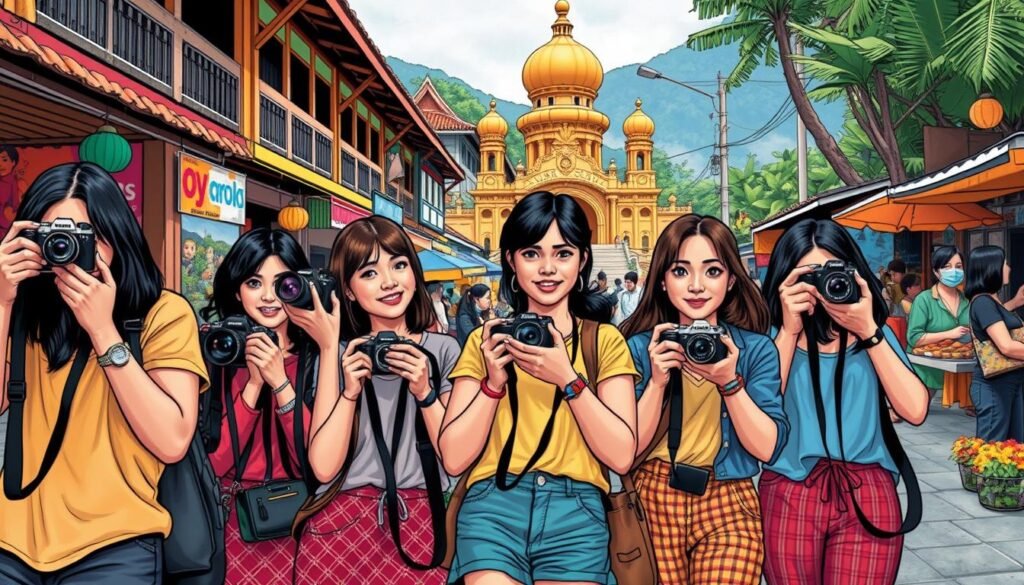
For more on women in photography, check out Sinaunang Panahon. It shares the stories of women changing the industry.
| Photographer | Notable Works |
|---|---|
| Shaira Luna | Playing Long After Us, fashion and lifestyle campaigns |
| Raena Abella | Overland adventure, documentary photography |
Environmental Photography and Advocacy
Environmental photography is key in showing us why we must protect our culture and memories of nature. Photographers use their work to tell stories about how we affect the environment. This can motivate people to take action to save our planet.
A workshop like the one by Milwaukee Riverkeeper teaches how to use photos for environmental causes. It shows how photography can be a powerful tool for change.
When taking environmental photos, photographers should remember a few things:
- Respect the subjects of their photos
- Follow ethical practices, like being patient and noninvasive
- Do research and know the laws and permissions
Photography can help us make a difference and promote a culture of sustainability. Pictures can stick in our minds longer than words. This makes photography a strong way to create lasting memories and emotions.
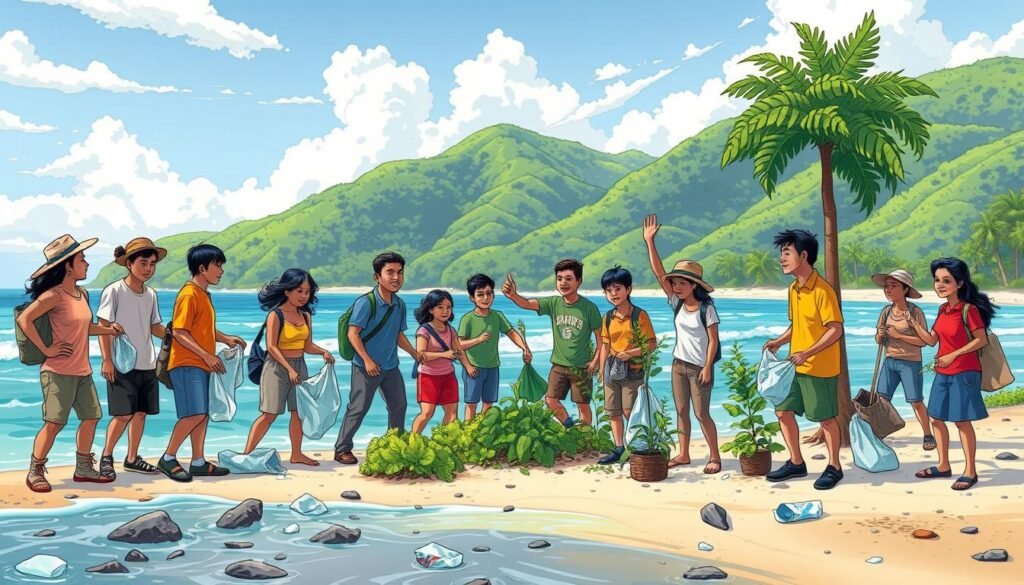
In the end, environmental photography and advocacy can lead to real change. They inspire us to act for a greener future through the power of images.
| Photography Type | Impact |
|---|---|
| Conservation Photography | Raise awareness and inspire emotional responses |
| Environmental Photography | Document environmental issues and events |
Portrait of the Filipino Photographer Today
The Filipino photographer today is full of life and creativity. They are skilled in many visual techniques. They also know how to use social media well.
Platforms like Instagram and Facebook give photographers a big chance to show their work. They can connect with people who might want to hire them.
Key skills for Filipino photographers include knowing how to edit photos and understanding lighting and composition. They also need to tell stories with their photos. Many use social media to grow their brand and find new clients.
Photographers like Lenny Limjoco and Lloyd Ramos have made a big impact. Limjoco’s book, “LARAWAN: Portraits Of Filipinos,” shows the power of photos. Ramos’s work has been seen around the world, showing the appeal of Filipino photography.
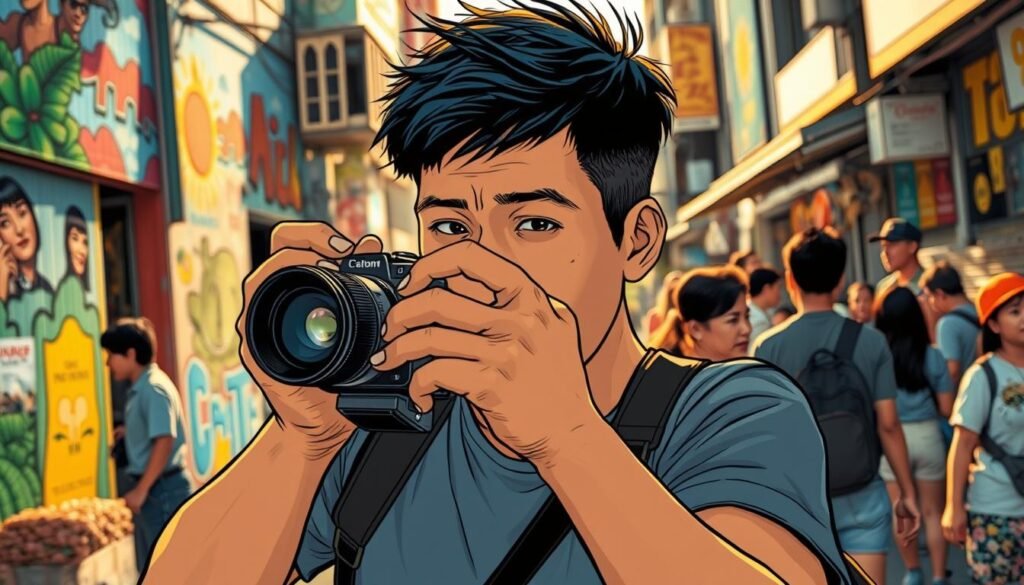
To do well, Filipino photographers need to be flexible, creative, and smart about business. They must understand the world of photos and social media. By improving these skills and having a strong online presence, they can succeed and make a difference in photography.
| Photographer | Notable Works |
|---|---|
| Lenny Limjoco | LARAWAN: Portraits Of Filipinos |
| Lloyd Ramos | Exhibited at the UK National Portrait Gallery and the Kiyosato Museum of Photographic Art |
Photography Competitions and Exhibitions
Photography competitions and exhibitions are key in sharing culture and stories through images. They give photographers a chance to show their work, get recognized, and meet others from all over. This helps in building a global community of photographers.
Some big names in these events are the Sony World Photography Awards, the World Press Photo Contest, and the Istanbul Photo Awards. These contests have different categories and prizes like cash, equipment, and international shows.
Entering these competitions can bring many benefits, such as:
- Gaining international recognition and exposure
- Building a portfolio and networking with other photographers
- Learning from feedback and critiques from industry experts
- Staying updated on the latest trends and techniques in photography
For instance, the Sony World Photography Awards has a $30,000 prize fund. The World Press Photo Contest reaches over 4 million people each year. The Istanbul Photo Awards gives a $6,000 prize for the Photo of the Year.
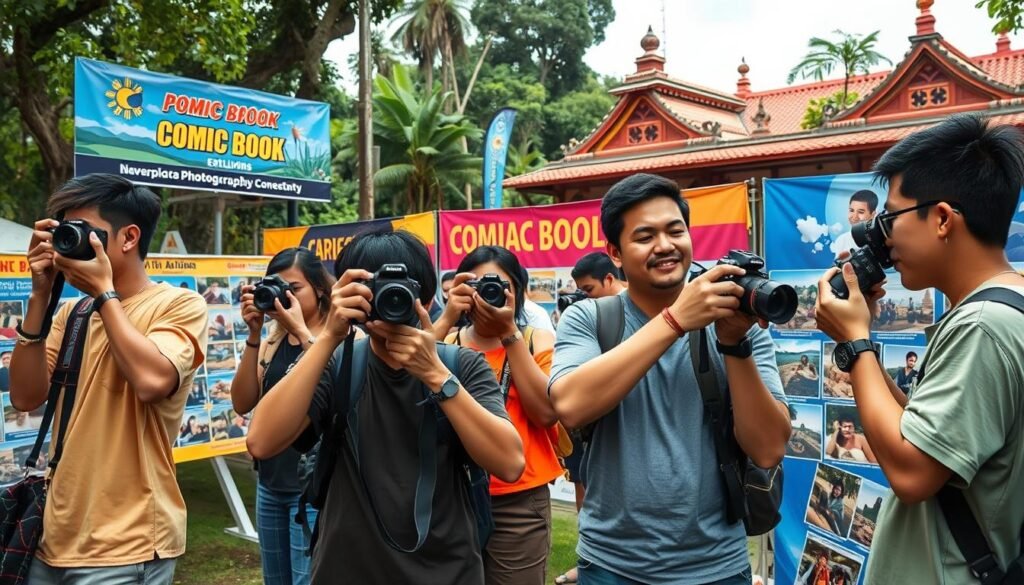
By joining these events, photographers can share their stories and culture. This helps in understanding and appreciating different cultures. Whether you’re a pro or just starting, these competitions offer a chance to show your work to a global audience.
| Competition | Prize | Deadline |
|---|---|---|
| Sony World Photography Awards | $30,000 | January 2025 |
| World Press Photo Contest | International recognition | January 2025 |
| Istanbul Photo Awards | $6,000 | January 2025 |
Future Trends in Philippine Photography
The photography scene in the Philippines is always changing. It’s key to keep up with new trends. One big trend is visual storytelling, which will grow on social media.
Social media has opened doors for photographers. They can now share their work and reach more people. With many Filipinos on Facebook and Instagram, photographers can promote their work and build their brand.

Other trends include virtual and augmented reality, and sustainable photography. It’s important for photographers to keep up with these trends and technologies. This way, they can stay competitive.
For those interested in ancient Filipino scripts, Baybayin is a great resource. By embracing these trends, photographers in the Philippines can keep producing great content. This content will engage their audience.
Emerging Styles and Techniques
- Increased use of drone photography
- Experimentation with new editing software and techniques
- Growing demand for visual storytelling
The Role of Virtual and Augmented Reality
Virtual and augmented reality are becoming more popular in photography. They offer new ways to capture and experience images.
Sustainability in Photography Practices
The industry is focusing more on sustainable practices. This includes using eco-friendly equipment and managing waste responsibly.
| Trend | Description |
|---|---|
| Visual Storytelling | Using images to tell a story and convey a message |
| Social Media | Using platforms like Facebook and Instagram to promote services and build a brand |
| VIRTUAL AND AUGMENTED REALITY | Using virtual and augmented reality to capture and experience images |
Conclusion: The Enduring Impact of Photography in the Philippines
Photography has become a key part of the Philippines’ culture. It captures and shapes . Photography is a strong tool for keeping the country’s heritage and stories alive.
With technology advancing, the in the Philippines is bright. New trends like and mobile photography have made it more accessible. This has encouraged a new wave of and deepened the appreciation for photography’s role in and bringing people together.
The next step is to use photography to protect the country’s culture, raise awareness, and inspire the next generation. By supporting education, exhibitions, and teamwork, the Philippines can keep the art of alive and growing.
FAQ
What is the significance of photography in Filipino culture?
Photography is key in Filipino culture. It captures memories and documents traditions. It’s a way for Filipinos to share their heritage with others.
How has the history of photography evolved in the Philippines?
Photography in the Philippines started with early influences. It grew with key developments and famous photographers. Today, it’s shaped by social media and visual platforms.
What are the popular photography styles in the Philippines?
The Philippines loves portrait, landscape, and street photography. Each style has its own challenges and opportunities. Social media has influenced these styles.
How has the rise of mobile photography impacted the photography landscape in the Philippines?
Smartphones and social media have changed photography in the Philippines. They’ve brought new trends and challenges for photographers.
What role do photography education and communities play in the Philippines?
Education and communities are vital for photography in the Philippines. They offer courses, online resources, and clubs. These help photographers grow and connect.
How has social media influenced photography in the Philippines?
Social media has changed how Filipino photographers work. It helps them share their work and connect with people. But, it also brings challenges.
What are the ethical considerations in photography in the Philippines?
Photographers in the Philippines must respect privacy and culture. They also need to handle copyright and intellectual property issues. This ensures their work is responsible.
How are technological advancements impacting photography in the Philippines?
New tech, like digital vs. film, is changing photography in the Philippines. Photographers must adapt and use these changes to their advantage.
What is the role of women in photography in the Philippines?
Women are making a big impact in Philippine photography. Despite challenges, they’re growing in the field. Their work is promoting diversity and inclusion.
How is environmental photography and advocacy being used in the Philippines?
Environmental photography is raising awareness in the Philippines. It documents climate change and encourages action. Photographers are using their work to make a difference.
What are the key skills and challenges faced by Filipino photographers today?
Filipino photographers need to master skills and techniques. Networking is also key. They must balance art and commerce to succeed.
What opportunities exist for Filipino photographers through competitions and exhibitions?
Competitions and exhibitions offer Filipino photographers a chance to shine. They can gain recognition and showcase their talent globally. These events are key for their careers.
What are the future trends in Philippine photography?
The future of Philippine photography includes new styles and tech. Virtual reality and sustainability are also important. Adapting to these trends will help photographers thrive.
Source Links
- Why Professional Family Portraits Matter for Filipinos – https://raconteurph.com/live/topic/018ecbc9-77f4-704f-9c4c-29b4ab1d4399/capturing-memories-why-professional-family-portraits-matter-for-filipinos
- Capturing memories never to be forgotten – https://www.sbs.com.au/language/filipino/en/podcast-episode/capturing-memories-never-to-be-forgotten/c22rjqv53
- Photography in the Philippines – https://en.wikipedia.org/wiki/Photography_in_the_Philippines
- Visual Rhetoric | A Pictorial Narrative of the Philippines:1889-1934 and Real Photography Postcards – https://pages.charlotte.edu/visualrhetoric/projects/individual-projects/the-narrative-of-real-photograph-postcards-through-the-history-of-photography-in-the-philippines1889-1934/
- Thinking About Colonial Photography Through the Photographs of the Menage Expedition to the Philippines – https://anzasablog.wordpress.com/2019/10/07/thinking-about-colonial-photography-through-the-photographs-of-the-menage-expedition-to-the-philippines/
- How Filipino Photographers are Breaking Barriers One Image at a Time — One Down – https://onedown.media/read/how-filipino-photographers-are-breaking-barriers-one-image-at-a-time
- Finding the Filipino in Living Pictures — Cartellino – https://cartellino.com/art/2023/04/26/Finding-the-Filipino-in-Living-Pictures
- This photo collective wants to create more regular exhibits for Filipino photographers – https://www.gridmagazine.ph/news-feed/photo-collective-fotomoto-exhibits-for-filipino-photographers
- Geloy Concepcion: Photographer Journey | From Digital To Film – https://pluralartmag.com/2022/02/05/geloy-concepcion-photography/
- Exploring Philippines Street Photography: Capturing Daily Life – https://www.kevin-moore.com/exploring-philippines-street-photography-capturing-daily-life/
- Filipino Culture Photography – https://www.pinterest.com/ideas/filipino-culture-photography/935910997603/
- The rise of mobile phone photography | Guardian photography guide – https://www.theguardian.com/artanddesign/2012/nov/16/mobile-photography-richard-gray
- The Rise of The Mobile Photography Era – An Interview With Lara Aucamp – https://fstoppers.com/originals/rise-mobile-photography-era-interview-lara-aucamp-169624
- History of Mobile Photography – https://moblivious.com/apple/ios-apps/history-of-mobile-photography/
- The School of Photography – Courses, Tutorials & Books – https://www.theschoolofphotography.com/
- The Benefits of Building Photography Communities and Giving Back – https://fstoppers.com/business/benefits-building-photography-communities-and-giving-back-345459
- The Intersection of Art and Activism: How Photography Can Drive Social Change – https://areai4africa.org/how-photography-can-drive-social-change/
- Has Social Media Been a Positive or Negative for the World of Photography? – https://fstoppers.com/business/social-media-been-positive-or-negative-world-photography-618075
- Photography and Social Media: How Photography Has Changed – https://www.first.edu/blog/digital-photography/photography-and-social-media-how-its-changed/
- What are photography ethics? – Photography Ethics Centre – https://www.photoethics.org/photography-ethics
- 2024 Guide to Ethical Photography and Copyright Compliance – https://aftershoot.com/blog/ethical-photography/
- Ethical Photography Practices: Yes, That’s Really a Thing. – https://wizwow.medium.com/ethical-photography-practices-yes-thats-really-a-thing-17bf5fc2839b
- How Digital Technology Has Changed Photography – https://www.dijifi.com/blog/how-digital-technology-has-changed-photography
- Technology of photography | Systems, Types, & Facts | Britannica – https://www.britannica.com/technology/technology-of-photography
- Photographer Spotlight: Shaira Luna, Fashion Photography – https://www.fotografia.ph/news/photographer-spotlight-shaira-luna-fashion-photography/
- Kat Palasi – Photoma 🇵🇭👁 – http://www.photoma.info/portfolio/kat-palasi/
- The impact of conservation photography | Adobe – https://blog.adobe.com/en/publish/2021/10/19/conservation-photography-photojournalism-using-your-photography-environmental-conservation
- Advocacy Vs Photojournalism In Conservation Photography – https://conservationvisuals.com/tutorials/advocacy-vs-photojournalism/
- Spotlight: LARAWAN: Portraits Of Filipinos, by Lenny Limjoco – Invisible Photographer Asia (IPA) – https://invisiblephotographer.asia/2013/04/17/spotlight-larawan-lennylimjoco/
- The First Filipino Photographer — IloiloArts – https://iloiloarts.com/the-first-filipino-photographer
- Gemma Cruz Araneta’s Vogue Cover Photographer Lloyd Ramos On What Informs His Practice – https://vogue.ph/lifestyle/people/photographer-lloyd-ramos-on-capturing-the-in-betweens/
- Open competition – https://www.worldphoto.org/sony-world-photography-awards/open
- Top Photography Contests to Enter in 2025 – https://www.all-about-photo.com/photo-articles/photo-article/1699/top-photography-contests-to-enter-in-2025
- Contemporary Arts in the Philippines: An Introduction – https://bluprint-onemega.com/architecture/heritage/an-introduction-to-contemporary-arts-in-the-philippines/
- Trends Examples in Philippines Shaping Everyday Life – https://seospecialist.com.ph/comprehensive-analysis-of-example-of-trends-in-the-philippines/
- Social Media in the Philippines: History, Use, Issues, & Trends – https://www.spiralytics.com/blog/social-media-in-the-philippines/
- The Importance of Photography- Student Interview and Essay of Photographer in Boise – Cherished Images – https://cherishedimages.net/the-importance-of-photography-student-interview-and-essay-of-photographer-in-boise/
- [IN PHOTOS] Shooting and developing the Cordillera soul: Eduardo Masferré in the digital age – https://www.rappler.com/life-and-style/arts-culture/photos-shooting-developing-cordillera-soul-eduardo-masferre-digital-age/

